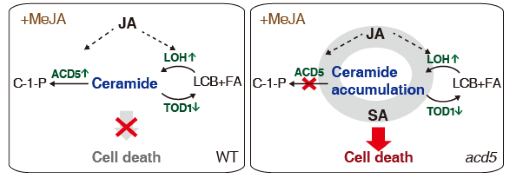Professor Nan Yao’s team reveals the functions of plant hormone pathways in regulating the sphingolipid metabolism and sphingolipid-related cell death
Source: School of Life Sciences
Edited by: Zheng Longfei, Wang Dongmei
Sphingolipids are a unique subset of primary membrane lipids that exist ubiquitously in eukaryotes. Plant sphingolipids perform critical functions, either as membrane structural components to maintain membrane integrity or as signals and mediators of processes in plant development and response to biological and abiotic stresses. Ceramide is the central component of sphingolipid metabolism, and its content change often affects the homeostasis of sphingolipid metabolism. The
accelerated cell death 5 (
acd5) mutants of Arabidopsis, which are defective in ceramide kinase, accumulate a large amount of ceramide in the later stage of growth, accompanied by spontaneous cell death phenotype and the increase of salicylic acid (SA) level. In
acd5, ceramide-induced cell death depends on SA pathway, but the molecular mechanism underneath and the function of other plant hormones in sphingolipid-related cell death are still unclear.
Professor Nan Yao’s team from the School of Life Sciences at Sun Yat-sen University found that
Arabidopsis thaliana lipase-like protein ENHANCED DISEASE SUSCEPTABILITY1 (EDS1) and its partner PHYTOALEXIN DEFINITION4 (PAD4) participate in sphingolipid metabolism and associated cell death (Figure 1). Loss of function of EDS1, PAD4, or SALICYLIC ACID INDUCTION DEFICIENT 2 (SID2) in the acd5 mutant background suppresses the acd5 cell-death phenotype and prevents ceramide accumulation. Several lines of evidence to support the idea that EDS1 and PAD4 contribute to ceramide-mediated SA accumulation and cell death.

Figure 1. The role of EDS1/PAD4 in ceramide-associated cell death
Meanwhile, Prof. Nan Yao’s team also revealed that jasmonate (JA) pathway is involved in mediating sphingolipid metabolism and ceramide-induced cell death (Figure 2). JA induced the accumulations of ceramides and hydroxyceramides which depends on the JA-Ile receptor CORONATINE INSENSITIVE1 (COI1) protein, a key factor of JA signaling pathway. This study found that JA participates in regulating the expression of genes related to ceramide metabolism through the key transcription factor MYC2.

Figure 2. Working model for JA regulation of sphingolipid metabolism and ceramide-associated cell death in
acd5.
These works were published in
Plant Journal with the title “The immune components EDS1 and PAD4 are required for cell death caused by overaccumulation of ceramides in Arabidopsis” and in
Plant Physiology with the title “Jasmonates modulate sphingolipid metabolism and accelerate cell death in the ceramide kinase mutant
acd5”. Dr. Hong-Yun Zeng and PhD student Li-Qun Huang are the first authors of the two papers, respectively. Professor Nan Yao is the corresponding author of these two papers. These works are supported by the National Natural Science Foundation of China, the Natural Science Foundation of Guangdong Province and Sun Yat-sen University.
Link to the papers:
https://onlinelibrary.wiley.com/doi/10.1111/tpj.15393
https://doi.org/10.1093/plphys/kiab362
